Author: Robbie Petersen, Delphi Digital Researcher
Compiled by: Luffy, Foresight News
The total supply of stablecoins continues to rise steadily, and this total masks a more concerning detail. Despite cryptocurrency trading volumes remaining below historical highs, the number of active addresses using stablecoins for transactions continues to climb each month. This discrepancy suggests that stablecoins are not merely serving as lubricants for the speculative casino of cryptocurrency but are finally delivering on their core promise: to become the foundation of a new digital financial system.
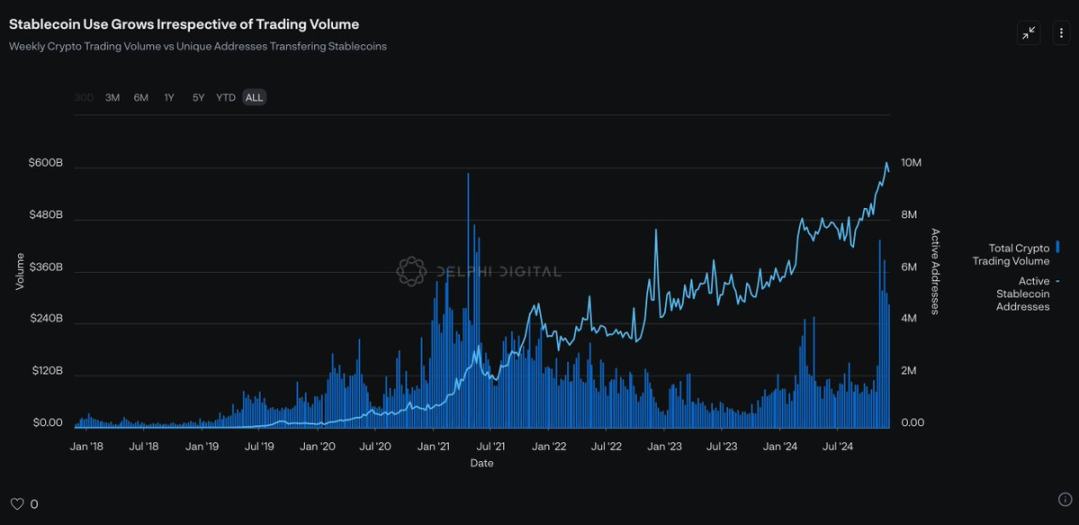
Source: Artemis, The Tie
Perhaps more importantly, some clear signs indicate that mass adoption may not necessarily come from emerging startups but from companies that already have established distribution channels. In just the past three months, four major fintech companies have officially announced their entry into the stablecoin space: Robinhood and Revolut are launching their own stablecoins; Stripe recently acquired Bridge to facilitate faster and cheaper global payments; and despite undermining their own interests, Visa is helping banks launch stablecoins.
This marks a new paradigm shift: the adoption of stablecoins is no longer dependent on purely ideological assumptions. Instead, by offering fintech companies a simple proposition of lower costs, higher profits, and new revenue streams, stablecoins find themselves aligned with one of the most reliable forces in capitalism: the relentless pursuit of profit. Therefore, as market-leading fintech companies leverage stablecoins to enhance profit margins and/or expand their payment stacks, we will inevitably see their other competitors follow suit and join the stablecoin battlefield. As I emphasized in the "Stablecoin Manifesto," game theory suggests that the adoption of stablecoins is not optional but a necessary bet for fintech companies to maintain their market positions.
Stablecoin 2.0: Revenue-Sharing Stablecoins
Intuitively, the most obvious beneficiaries of these structural tailwinds are the issuers of stablecoins. The reason is simple: considering the network effects of currency, stablecoins are essentially a winner-takes-all game. Today, these network effects manifest primarily in three ways:
- Liquidity: USDT and USDC are the most liquid stablecoins in the cryptocurrency market, and using some emerging stablecoins means traders have to bear more slippage;
- Payments: USDT has become an increasingly common payment method in emerging economies, and its network effect as a digital medium of exchange is arguably the strongest;
- "Denomination Effect": Almost all major trading pairs on CEX and DEX are denominated in USDT or USDC.
In simple terms, the more people use USDT (Tether), the more convenient it becomes to use USDT, leading to even more people using USDT. The result is that Tether increases its market share while enhancing profitability.
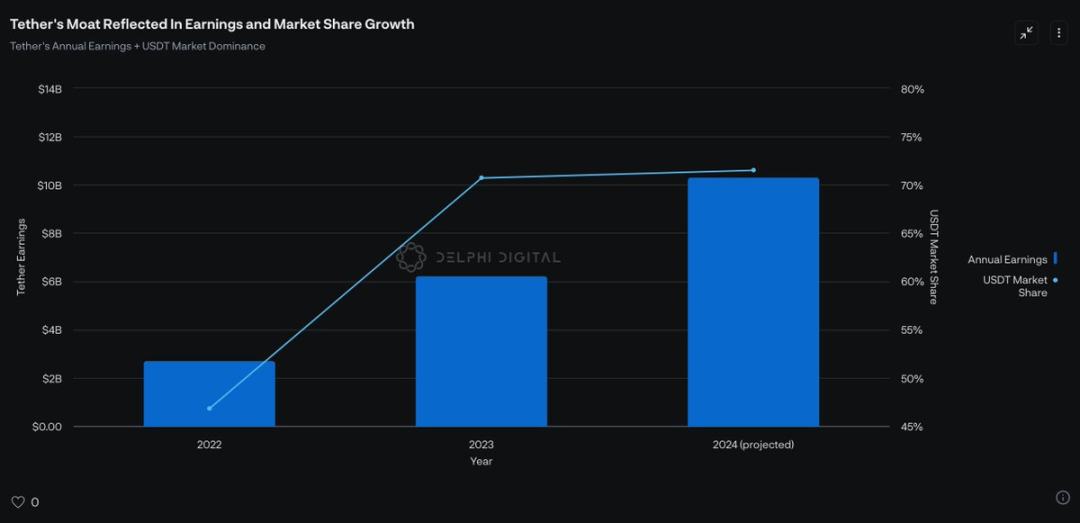
While Tether's network effects are nearly impossible to fundamentally disrupt, a new emerging stablecoin model seems best suited to challenge Tether's existing model: revenue-sharing stablecoins. Importantly, this model is well-positioned within the stablecoin paradigm increasingly adopted by fintech companies. To understand why, it is necessary to grasp a few prerequisites.
Today, the stablecoin ecosystem typically includes two main participants: (1) stablecoin issuers (e.g., Tether and Circle) and (2) stablecoin distributors (i.e., applications).
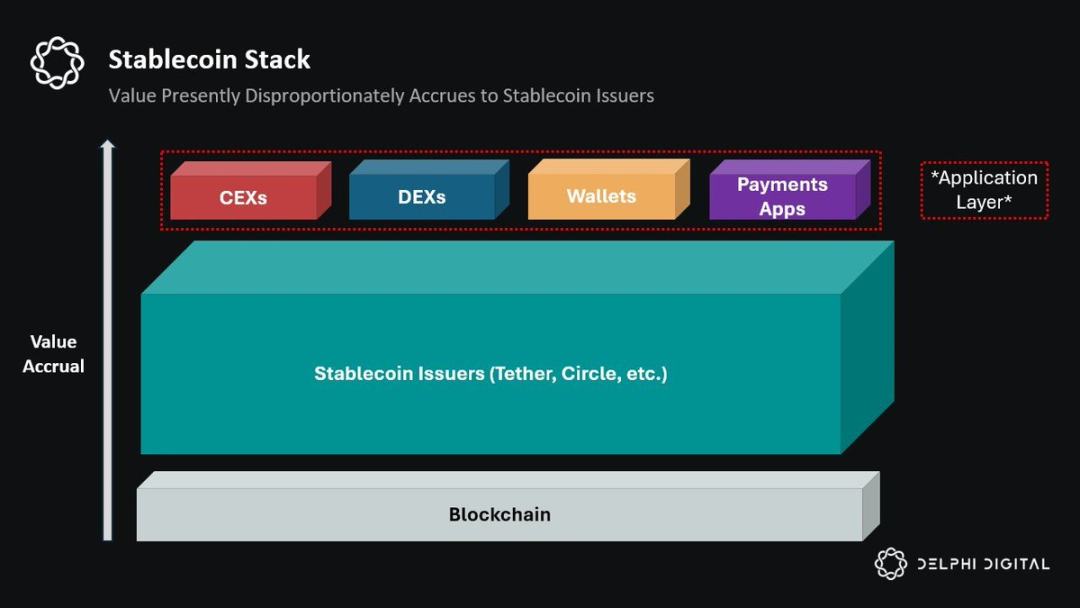
Currently, stablecoin issuers create value of over $10 billion annually, exceeding the total revenue of all blockchains combined. However, this represents a significant structural inefficiency: the value generated within the stablecoin stack fundamentally resides with downstream distributors. In other words, without exchanges, DeFi applications, payment apps, and wallets integrating USDT, USDT would have no utility and thus generate no value. Nevertheless, the "distributors" currently do not receive corresponding economic benefits.
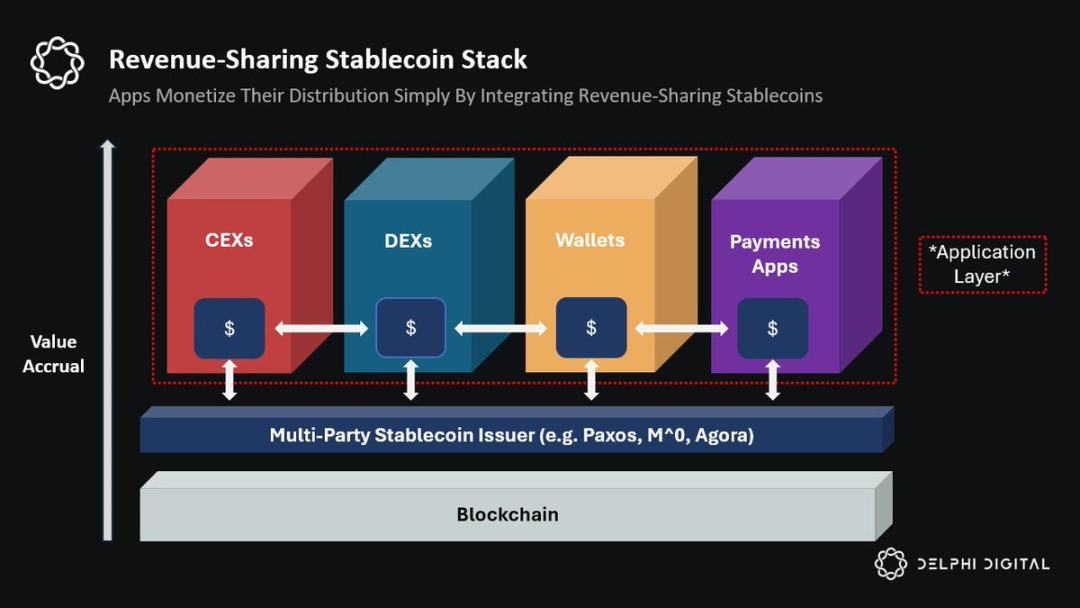
This has led to the rise of a new class of stablecoins: revenue-sharing stablecoins. By redistributing the economic benefits traditionally captured by stablecoin issuers to the applications that bring users to the collective network, this model disrupts the existing system (the USDT model). In other words, revenue-sharing stablecoins enable applications to effectively share in the profits generated from their own distribution channels.
From a scale perspective, this could represent a meaningful source of revenue, potentially becoming the primary revenue source for large applications. Therefore, as profit margins continue to be squeezed, we may enter a world where the primary business model for crypto applications evolves into effectively selling "stablecoin issuance as a service" (SDaaS). Intuitively, this makes sense, as stablecoin issuers currently capture more value than the total of blockchains and applications combined, and the portion of value applications receive could be significantly larger than from other sources.
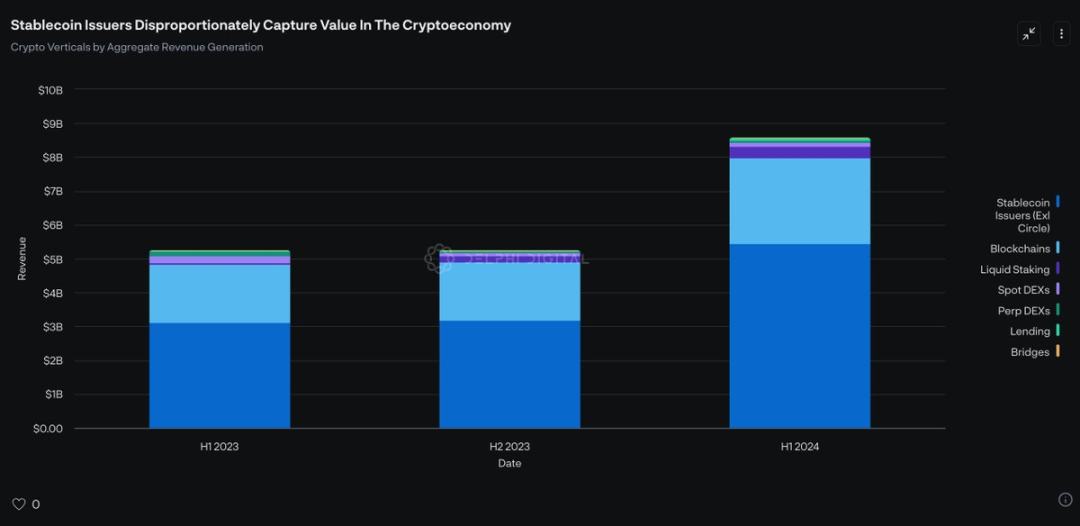
Although there have been countless attempts to break Tether's monopoly, I believe the revenue-sharing stablecoin model is the right direction for two reasons:
- Distribution is everything: While previous attempts to issue yield-bearing stablecoins primarily sought support from end users, revenue-sharing stablecoins target participants who already have users: distributors. This indicates that the revenue-sharing model is the first to inherently combine the incentive mechanisms of both distributors and issuers.
- Quantity determines power: Historically, the only way applications could gain economic benefits from stablecoins was to launch their own independent stablecoin. However, this approach comes at a cost. Given that other applications have no incentive to integrate your stablecoin, its utility would be limited to their respective applications. Therefore, it is unlikely to compete at scale with the network effects of USDT. In contrast, by creating a stablecoin that incentivizes numerous distribution-capable applications to integrate simultaneously, revenue-sharing stablecoins can leverage the collective network effects of the entire "distributor" ecosystem.
In short, revenue-sharing stablecoins possess all the advantages of USDT (cross-application composability and network effects) while having the additional benefit of incentivizing participants with distribution channels to integrate and share profits with the application layer.
Currently, there are three leaders in the revenue-sharing stablecoin space:
- Paxos' USDG: Paxos announced the launch of USDG in November this year, regulated under the upcoming stablecoin framework from the Monetary Authority of Singapore, and has secured heavyweight partners including Robinhood, Kraken, Anchorage, Bullish, and Galaxy Digital.
- M^0's "M": The team consists of former senior members from MakerDAO and Circle, and M^0's vision is to serve as a simple, trusted neutral settlement layer that allows any financial institution to mint and redeem M^0's revenue-sharing stablecoin "M." However, one distinction of "M" from other revenue-sharing stablecoins is that "M" can also serve as "raw material" for other stablecoins, such as USDN (Noble's revenue-sharing stablecoin). Additionally, M^0 employs a unique custody solution consisting of a decentralized network of independent validators and a dual-token governance system, offering higher trusted neutrality and transparency compared to other models. You can read more about M^0 in my post.
- Agora's AUSD: Similar to USDG and "M," Agora's AUSD also shares revenue with applications and market makers that integrate AUSD. Agora has also received strategic support from numerous market makers and applications, including Wintermute, Galaxy, Consensys, and Kraken Ventures. This is noteworthy as it aligns incentives with these stakeholders from the outset. Currently, AUSD has a total supply of $50 million.
By 2025, I expect these stablecoin issuers to gain increasing attention as distributors collaborate and guide users to use stablecoins that benefit them. Additionally, we should see market makers (who play a crucial role in ensuring stablecoins maintain sufficient liquidity) show a preference for these stablecoins, as they can also gain certain economic benefits from holding such stablecoin inventories.
While "M" and AUSD currently rank 33rd and 36th in stablecoin supply, respectively, and USDG has yet to launch, I anticipate that by the end of 2025, at least one of these stablecoins will break into the top 10. Furthermore, by the end of the year, I expect the overall market share of revenue-sharing stablecoins to rise from 0.06% to over 5% (approximately 83 times), as large fintech companies with distribution capabilities usher in the next wave of stablecoin adoption.
Stablecoins on the Rise
While the adoption curve of Eurodollars is often used as a historical analogy for stablecoins, this analogy is somewhat simplistic. Stablecoins are not Eurodollars; they are inherently digital, can be used globally, can settle cross-border transactions instantly, can be utilized by AI agents, and are influenced by large-scale network effects; most importantly, existing fintech companies and enterprises have clear incentives to adopt them, as stablecoins align with every business's goal: to make more money.
Therefore, to say that the adoption of stablecoins will follow the trajectory of Eurodollar adoption overlooks a fundamental issue. I believe the only commonality between stablecoins and Eurodollars is that they will continue to emerge as a bottom-up phenomenon, and no institution or government that perceives the technology as contrary to their interests will be able to control them. However, unlike Eurodollars, the adoption of stablecoins will not occur slowly over 30-60 years. It will start slowly and then suddenly explode as network effects rapidly reach escape velocity.
Regulatory frameworks are being established. Fintech companies like Robinhood and Revolut are launching their own stablecoins, and Stripe seems to be exploring stablecoins to gain more payment stack. Most importantly, despite potentially eating into their profits, existing companies like PayPal and Visa are still exploring stablecoins because they fear that if they do not, their competitors will.
While it remains unclear whether 2025 will be a turning point in the history of stablecoin development, it is evident that we are approaching that turning point.
免责声明:本文章仅代表作者个人观点,不代表本平台的立场和观点。本文章仅供信息分享,不构成对任何人的任何投资建议。用户与作者之间的任何争议,与本平台无关。如网页中刊载的文章或图片涉及侵权,请提供相关的权利证明和身份证明发送邮件到support@aicoin.com,本平台相关工作人员将会进行核查。




